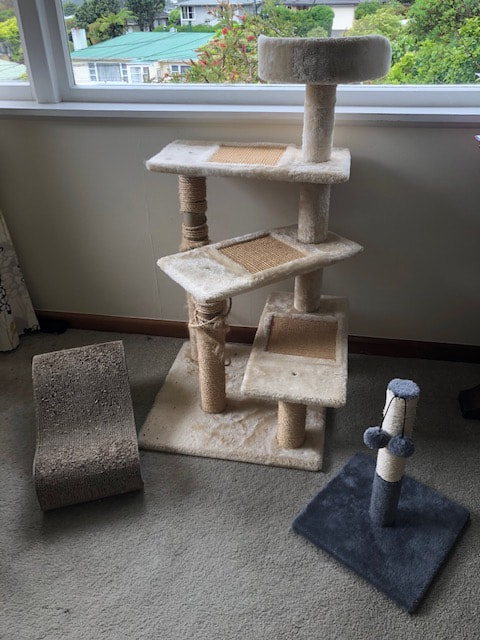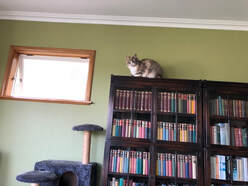|
So the world has gone a bit topsy-turvy and all these changes and uncertainty can cause quite a bit of stress and concern for us humans – and also for our cats. They’re used to a particular routine and being able to predict what’s happening in their environment is how they make sense of the world and detect if there's a potential threat out there. So with a lot of us suddenly working from home, with children at home too, that’s a completely new routine for a lot of households - plus more noise and activity and your cats are going to notice these changes. Also, cats are very sensitive to our moods and so if we’re stressed and agitated, they will pick up on our change in mood as well. A couple of suggestions:
Firstly, as much as possible, keep to a routine. That means keeping to a routine for feeding as well as letting your cat inside and out. • For feeding – try to keep to a routine for mealtimes – it doesn’t need to be to the minute, but some consistency will help your cat know when food is available (key for their survival instinct). • Also with letting inside/out - the UK's RSPCA website says: If your cat is used to staying in then try and keep them inside making sure they have access to their litter tray and that it is cleaned regularly. If your cat is used to coming and going as they please, keeping them inside could be very stressful and may make them ill. We would advise minimising interactions with them and washing your hands thoroughly after contact with them or any of their items. https://www.rspca.org.uk/whatwedo/latest/blogs/details/-/articleName/how-to-care-for-your-pets-if-you-re-ill-or-have-to-self-isolate-due-to-coronavirus
When possible, people who are sick or under medical attention for COVID-19 should avoid close contact with their pets and have another member of their household care for their animals. If they must look after their pet, they should maintain good hygiene practices and wear a face mask if possible. https://www.oie.int/en/scientific-expertise/specific-information-and-recommendations/questions-and-answers-on-2019novel-coronavirus/ To help reduce stress: The second suggestion is one based on research that shows that cats like to have somewhere to hide where they will be undisturbed by children, other animals … and yes, even us adults who like to go and check on them from time-to-time. It’s an avoidance strategy. It means that when they’re stressed they can go somewhere to avoid the source of the stress and relax. This is beneficial for them because it keeps their stress-hormone, cortisol, in check and it means they have somewhere they feel safe – and safety is so important to good wellbeing. You might need to get creative and make somewhere high up accessible and out of reach if you have little children or dogs. So it might be up high on top of a bookcase or chest of drawers, or snuck into a cupboard (make sure they can get out again) or a cardboard box tucked away somewhere with a blanket. If your cat regularly goes someplace, they're telling you they feel safe there. Just let them be and know they’re taking their own time out. How clever are they eh?!
3 Comments
Having a new baby is very exciting ... introducing the baby and cat can be more of a challenge. From a cat' s perspective it means there's a new being in the house that smells different, there are pieces of furniture, pram, stroller, toys that bring new smells and sounds, disruption to the usual routines - the list goes on. For some cats this is stressful and you might find they stay away from the house for a while - especially when your baby cries. Download the file below which provides some suggestions to help create a cat-friendly home before your baby arrives. It also covers how to introduce your baby and cat. Download now at the link below - it's free!
 Before tackling the issue of destructive scratching, first let’s understand that scratching is a perfectly normal behaviour for a cat. They do it for 3 reasons:
Bateson, 2014); and
You might also see a cat using a vertical scratching post shortly after they wake from a curled up sleep – great for stretching out their limbs. When I’m doing assessments in people’s homes, I’m looking for a scratching post or horizontal scratching pads. Sometimes there are posts or cat trees and sometimes there’s nothing … and then the cats will usually have used whatever is available to them, including the carpet or sofa. The corner of a sofa, to a cat, is a good option, being tree-like of fence-like – and once chosen, they will return to it to replenish their territorial marking (Turner & Bateson, 2014). In this post I’ll explain about the types of suitable scratching materials and why it’s important to think about the size and location of the post or pad. And then I’ll go on to give you tips on ways to teach your cat to use the new scratcher. Scratching posts or pads We don’t mind our feline friends scratching fence-posts or trees, but when scratching within our homes, we get upset if our sofa, walls, curtains that get the scratching treatment. The inside of our homes are part of a cat’s core territory so we need to do 2 things:
The ideal is to provide both vertical and horizontal options as some cats prefer one or the other and some like both. After a cat wakes up, they will often want a tall post to use and have a good stretch of their limbs. When they’re frustrated they might instead use a horizontal pad to vent their energy. Some things to consider with vertical scratching posts:
In the picture on the right, you’ll see a very well-used scratching post on the cat tree.This is in my lounge and I haven’t replaced it because it has my cat Poppy’s scent on it – she uses this post every day.What I’ve done is to buy some more sisal which I’m going to replace one post at a time so it’s not removing all of her scent at one time. Or I might buy a new cat tree and stand it next to this one so she can start to put her scent onto it – and only then will I remove the old one. On the right of the picture you can see a tiny wee post.A friend bought that and she had an adult cat and it wasn’t used at all and instead the cat caused quite a lot of damage to her carpet. On the left is a figure 8 scratch pad which is very well used.This is usually placed in a room off the kitchen, near to where Selkie and Poppy eat.It’s also near to some doors through which they see into the back garden where there are birds and the occasional visit from a neighbouring cat.Then I’ll see them madly scratching the pad. In a recent study by Zhang, Plummer and McGlone (2019), they evaluated kitten preferences towards different scratchers. Their findings were that the S-shaped cardboard (similar to the figure 8 version), is most preferred.The authors acknowledge though that this doesn’t match other survey-based studies which probably reflects the fact that different cats have different preferences and may even like both vertical and horizontal scratching options.
Teaching your cat what to scratch (and what they can’t!) The first step is to encourage use of the new scratching post. If your cat responds to catnip, place some on the post to draw attention to it. Or you might use a wand-type toy to entice your cat to use the post and then, when they do, tell them they’re a good girl/boy and provide a food treat. To prevent your cat from scratching the sofa, consider placing a towel, blanket or throw over the scratched site. Then if they try to get to the site, gently move them to the new scratching post and give a treat, praise when s/he uses it. You will need to do this consistently so that the behaviour you want to see repeated – in this case scratching the sisal scratching post – is positively reinforced. Cats don’t respond to punishment so please don’t shout/yell or punish your cat if they try to use the sofa – remember this is a normal behaviour for them and if you yell, they don’t know they shouldn’t do that and they will become fearful and distrusting of you. Instead, gently move them to the new scratcher and praise when they use it. If you have a scratching post as part of a cat tree, think about locating it near to a window so they have a high up perch to look outside. Or locate it near to a pathway to escape another cat, dog or young children e.g. place near to a cabinet so they can access that either to sit on or as part of an escape route. References: Turner, D. and Bateson, P. (2014). The Domestic Cat. 3rd ed. Cambridge: University of Cambridge, UK. Zhang, L., Plummer, R. and McGlone, J. (2018). Preference of kittens for scratchers. Journal of Feline Medicine and Surgery, 21(8), pp.691-699. Why seek the advice of a cat behaviourist?
I set up Cat Behavioural Solutions (CBS) with the aim of helping people manage and resolve their cat’s behavioural problems and restore the joy that cats can bring to our lives and our relationship with them. Often behavioural problems are actually perfectly normal behavioural traits for cats living in the wild. To a great extent their brain is still hard-wired for that type of living and they need to learn to live with people, adapt to living in our homes and with our routines. A lot of cats are quite resilient and can cope but for some, life with humans – and quite often with another cat in the house - can be very stressful. Their behavioural responses, while normal in the wild is not what we expect or want in our homes and this can make for a tense and challenging relationship. What does a cat consultation involve? Cats are very individual and resolving behavioural issues means taking into account the cat’s breed, history (when known), the living environment and interactions with people and other pets. It’s not always easy to pin-point the reason(s) for your cat’s urine spraying or opting not to use the litter box, for scratching the furniture or attacking our hands and feet and so the most effective way is through gathering information and observing the cat in its home environment. The process …
My Guiding Principles The Five Freedoms (https://www.rnzspca.org.nz/animal-welfare/the-5-freedoms) is a particularly useful framework for ensuring a cat has a good quality of life. It addresses the cat’s needs for food and water but far more than that – this includes the freedom for your cat to interact – or avoid – others depending on their choice. It also reminds us that animals (in this case cats) need an environment that gives them freedom from fear and distress which can lead to poor mental health, stress and suffering. This is where the research into environmental enrichment is so useful and provides evidence-based findings to manage the environment and help to modify the cat’s behaviour. This process will require your patience – your cat’s behaviour won’t change overnight so perseverance is key. |
AuthorJeannette Vine Archives
March 2020
Categories |
||||||

 RSS Feed
RSS Feed